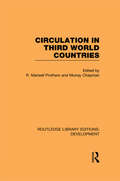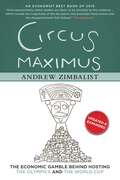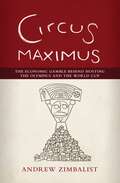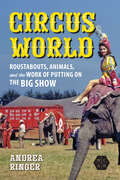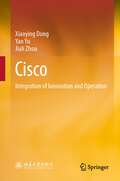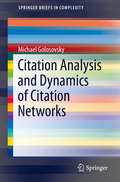- Table View
- List View
Circular Migration and the Rights of Migrant Workers in Central and Eastern Europe: The EU Promise of a Triple Win Solution (IMISCOE Research Series)
by Zvezda VankovaBy adopting a rights-based approach, this open access book sheds light on the different legal and policy instruments that have been adopted to implement circular migration policies in the EU and their consequences for the rights of migrant workers. It contributes to the understanding of the meaning of this concept in general, in the EU, as well as more specifically with regard to its Eastern neighbourhood. The book provides a comprehensive overview of the formation and implementation of the EU’s circular migration approach that has developed through both EU and national instruments on the basis of comparative case study analysis of Bulgaria and Poland’s migration law and policy. Furthermore, by applying legal empirical research methods, it draws conclusions about the policy outcomes from the implementation of the various migration instruments falling under the circular migration umbrella and shows the consequences for the rights of migrant workers as a result of the application of different policy options.Along with its value to an academic audience, the book can be used by policy makers at the EU, international and national level as well as international organisations and NGOs working in the field of migration law and policy.
Circular Supply Chain Management: A Sustainability Approach (Circular Economy and Sustainability)
by Jayakrishna Kandasamy Vimal K E K Manavalan Ethirajan Nishal MuraliThis book provides fundamental knowledge of theories on the circular economy and circular supply chain management. It also discusses theories that have been developed or adopted in circular economy research. Traditional supply chains organizations have felt the importance of transforming their activities to become more circular. This book provides insights into the need for adopting circular supply chain practices and the circular business models they can adopt. Barriers that supply chain organizations will encounter in their efforts to expediate the transformation, and the drivers that they will need to achieve these goals, are elaborated in the book. The key factors that help in the decision-making process and modalities involved in modelling the circular chains are also discussed. These will be of great value to managers and other stakeholders. Additionally, the role of I4.0 technologies in future supply circular chains is elucidated. This book also offers solutions to supply chain organizations for achieving the sustainable development goals. Case studies and illustrations are provided in each chapter for easy understanding of theory to practice.
Circular Supply Chains: How to Build the Future of Sustainable Operations
by Deborah DullAs supply chain operations continue to be recognized as critical to the transition to a circular economy, this practical resource provides an actionable outline for supply chain professionals wanting to implement a circular supply chain.The circular economy remains a common topic among supply chain professionals, especially in light of material disruptions, climate change pressures and the need to innovate on revenue models. Circular Supply Chains provides a bold vision of sustainability for supply chain designers, decision makers and operators to rally around. It will also, critically, provide a practical path on how to get from today's operations to the future of sustainable supply chains.Exploring topics like new digital technologies and the future of local supply chains, the book takes a practical approach including how-to checklists and circular supply chain examples. The book itself paints a vision and breaks theories down into reasonable, practical steps with concepts like repair demand sensing, supply planning, radical transparency and regenerative operations. This is an essential book for supply chain professionals keen to learn about how to transition to circular operations.
Circularity Assessment: Accountability Towards Sustainability
by Seeram Ramakrishna Rashmi Anoop PatilThis open access book attempts to provide a perspective on the circularity assessment at different levels of the systemic hierarchy and advocates better resource management for a sustainable future. It demonstrates how relevant circularity indicators are used for quantifying the extent of circularity of each level. Illustrative case studies that discuss the process of quantitatively interpreting progress towards circularity are provided. This work caters to a broad readership inclusive of governance, basic research, engineering, and business stakeholders. The conclusion signifies the role of consumer community in achieving circularity.
Circulation in Third World Countries (Routledge Library Editions: Development)
by R. Mansell Prothero Murray ChapmanCirculation is common in Third World countries and involves reciprocal flows of people, goods and ideas. The essays in this volume, first published in1985, discuss concepts associated with circulation in its various forms, and they present empirical evidence based on field work from holistic, ecological, social, and economic points of view. Contributions from Latin America, the Caribbean, Africa, Asia and the Pacific come from an international group of authors representing a variety of disciplines in the social sciences. All who are concerned with social and economic development need to recognise the importance of circulation at all levels of society and polity.
Circus Maximus
by Andrew ZimbalistAthletes compete for national honor in Olympic and World Cup games. But the road to these mega events is paved by big business. We all know who the winners on the field are-but who wins off the field?The numbers are staggering: China spent $40 billion to host the 2008 Summer Olympic Games in Beijing and Russia spent $50 billion for the 2014 Sochi Winter Games. Brazil's total expenditures are thought to have been as much as $20 billion for the World Cup this summer and Qatar, which will be the site of the 2022 World Cup, is estimating that it will spend $200 billion.How did we get here? And is it worth it? Those are among the questions noted sports economist Andrew Zimbalist answers in Circus Maximus: The Economic Gamble Behind Hosting the Olympics and the World Cup. Both the Olympics and the World Cup are touted as major economic boons for the countries that host them, and the competition is fierce to win hosting rights. Developing countries especially see the events as a chance to stand in the world's spotlight.Circus Maximus traces the path of the Olympic Games and the World Cup from noble sporting events to exhibits of excess. It exposes the hollowness of the claims made by their private industry boosters and government supporters, all illustrated through a series of case studies ripping open the experiences of Barcelona, Sochi, Rio, and London. Zimbalist finds no net economic gains for the countries that have played host to the Olympics or the World Cup. While the wealthy may profit, those in the middle and lower income brackets do not, and Zimbalist predicts more outbursts of political anger like that seen in Brazil surrounding the 2014 World Cup.
Circus Maximus: The Economic Gamble Behind Hosting the Olympics and the World Cup
by Andrew ZimbalistThe numbers are staggering: China spent $40 billion to host the 2008 Summer Olympic Games in Beijing and Russia spent $50 billion for the 2014 Sochi Winter Games. Brazil's total expenditures are thought to have been as much as $20 billion for the World Cup this summer and Qatar, which will be the site of the 2022 World Cup, is estimating that it will spend $200 billion. How did we get here? And is it worth it? Those are among the questions noted sports economist Andrew Zimbalist answers in Circus Maximus: The Economic Gamble Behind Hosting the Olympics and the World Cup. Both the Olympics and the World Cup are touted as major economic boons for the countries that host them, and the competition is fierce to win hosting rights. Developing countries especially see the events as a chance to stand in the world's spotlight. Circus Maximus traces the path of the Olympic Games and the World Cup from noble sporting events to exhibits of excess. It exposes the hollowness of the claims made by their private industry boosters and government supporters, all illustrated through a series of case studies ripping open the experiences of Barcelona, Sochi, Rio, and London. Zimbalist finds no net economic gains for the countries that have played host to the Olympics or the World Cup. While the wealthy may profit, those in the middle and lower income brackets do not, and Zimbalist predicts more outbursts of political anger like that seen in Brazil surrounding the 2014 World Cup.
Circus World: Roustabouts, Animals, and the Work of Putting on the Big Show (Working Class in American History)
by Andrea RingerFrom the 1870s to the 1960s, circuses crisscrossed the nation providing entertainment. A unique workforce of human and animal laborers from around the world put on the show. They also formed the backbone of a tented entertainment industry that raised new questions about what constituted work and who counted as a worker. Andrea Ringer examines the industry-wide circus world--the collection of shows that traveled by rail, wagon, steamboat, and car--and the traditional and nontraditional laborers who created it. Performers and their onstage labor played an integral part in the popularity of the circus. But behind the scenes, other laborers performed the endless menial tasks that kept the show on the road. Circus operators regulated employee behavior both inside and outside the tent even as the employees themselves blurred the line between leisure and labor until, in all parts of the show, the workers could not escape their work. Illuminating and vivid, Circus World delves into the gender, class, and even species concerns within an extinct way of life.
Cirque du Soleil
by Thomas J. Delong Vineeta VijayaraghavanRetaining talent is an issue for any company whose success relies on the creativity and excellence of its employees. This is especially true for Cirque du Soleil, the spectacularly successful "circus without animals," whose 2,100 employees include 500 artists--mimes, clowns, acrobats, gymnasts, musicians, and production professionals. Managing a company full of creative people is a juggling act in itself, between keeping its artists happy and pursuing a successful strategy for attracting more business and talent.
Cirque du Soleil--The High-Wire Act of Building Sustainable Partnerships
by Ramon Casadesus-Masanell Maxime AucoinThe case describes the history and business model of Cirque du Soleil (CdS). The case allows for a rich discussion and analysis of Cirque du Soleil's business model with an emphasis on how it interacts with that of MGM Mirage. Le Cirque and MGM's business models complement one another: MGM makes important capital investments in theaters tailored to CdS's shows that are located in the middle of MGM casinos, CdS acts as a magnet for traffic for an exclusive clientele that spends large amounts of money at the casino. CdS's partnership with MGM has been tremendously profitable. This raises the question of why hold up and opportunism have not destroyed competitive advantage for both entities: What features in CdS and MGM Mirage's business models have resulted in such a successful partnership? The case is set at a juncture where Daniel Lamarre (CdS's CEO) is looking for new opportunities for growth. Lamarre is pondering the likelihood of success of Cirque's first resident show in Asia at Tokyo Disney Resort, its entry in the Macao market, and a new partnership with two subsidiaries of Dubai World, the sovereign wealth fund of the Emirate. The question is: Can Le Cirque find a new model of complementary relationships that will be as profitable as its relationship with MGM Mirage?
Cisco Business Councils: Unifying a Functional Enterprise with an Internal Governance System
by Ranjay GulatiIn response to the 2001 market downturn, Cisco Systems implemented a major restructuring that transformed the company from a decentralized to centralized organization. While recognizing that a centralized, functional structure was necessary to avoid product and resource redundancies, it also risked making the company less customer-centric. To mitigate this risk, Cisco implemented a cross-functional system of executive-level councils that would bring leaders of different functions together to collaborate and focus on the needs and issues of specific customer groups. Each council employs a "Three-in-a-Box" leadership model consisting of an executive leader from the engineering or technology business unit, a member of the go-to-market team, and an operations resource director. Each council is also accountable to the Operating Committee, which is chaired by CEO John Chambers and determines the long-term corporate strategy and allocation of corporate resources. Many other companies have failed at facilitating collaboration across functions-particularly large organizations-but Cisco's system has been successful because the company remained committed to the system, required a consistent infrastructure while also allowing for flexibility, gave members decision making authority, and used council leaders who thrive in collaborative environments. The success of the council system led to the creation of 20 boards of "sub-councils" in 2007. The boards are charged with driving development efforts and customer reach further into the organization by addressing specific issues too narrow for the councils to address.
Cisco Systems Architecture: ERP and Web-enabled IT
by Richard L. Nolan Christina Akers Kelley PorterIn a seven-year process, Cisco built its strategic I-Net. Beginning in 1994, Cisco completely replaced its back-office legacy systems. At that time, the company standardized Internet protocols. In addition, the company shifted strategic focus from IT back-office applications to front-office applications. After ERP (enterprise resource planning), the company spent the next two years electronically connecting with customers. A rewritten version of two earlier cases. A consolidated version of the Cisco Systems ERP and Cisco Systems Web-enablement cases. Designed to be taught in one class session (if two class sessions are available, it is recommended that Cisco ERP Systems be used for one session followed by Cisco Systems Web-enablement).
Cisco Systems, Inc.: Acquisition Integration for Manufacturing (A)
by Steven C. Wheelwright Nicole Tempest Charles A. Holloway Christian G. KasperDescribes the procedures and processes used by Cisco Systems in its acquisition of high-technology firms. Its goal is to retain key engineering talent and to leverage existing product development efforts, but to quickly merge acquired companies its own systems and procedures. In addition to describing the general approach used by Cisco, this case describes some of the specifics involving its acquisition of Summa Four, a designer/manufacturer of a related product line, whose major activities are located in New England.
Cisco Systems, Inc.: Acquisition Integration for Manufacturing (B)
by Steven C. Wheelwright Christian G. KasperSupplements the (A) case.
Cisco Systems, Inc.: Implementing ERP
by Robert D. Austin Richard L. Nolan Mark CotteleerReviews Cisco System's approach to implementing Oracle's Enterprise Resource Planning (ERP) software product. This case chronologically reviews the diverse, critical success factors and obstacles facing Cisco during its implementation. Cisco faced the need for information systems replacement based on its significant growth potential and its reliance on failing legacy systems. The discussion focuses on where management was particularly savvy in contrast to where it was the beneficiary of good fortune.
Cisco Systems: Are You Ready? (A)
by James L. Heskett John P. MorgridgeAn Internet service provider, INS, in which Cisco Systems has a minority ownership stake, receives an offer of $3.1 billion from Cisco's rival Lucent. Cisco's management has to decide whether to act on a request from INS management that Cisco make a counteroffer. The decision requires that Cisco's highly successful strategy be revisited.
Cisco Systems: Building and Sustaining a Customer-Centric Culture
by Ranjay GulatiCustomer centricity has been an important part of the culture at Cisco Systems since its inception. While part of this is attributable to values put in place by the founders and retained by subsequent management, it is also closely interwoven with its organizational architecture that reaffirmed those values. Until 2001, Cisco had a decentralized organizational structure with three business units organized around each of its three main customer types: Service Provider, Enterprise, and Commercial. Each unit developed and marketed a complete product line for its specific customer group further reaffirming its belief in the centrality of distinct customers. A number of other systems, structures, and behavioral mechanisms reaffirmed the importance of customer centricity. The 2001 market downturn, however, brought new challenges as Cisco was forced to lay off 18% of its workforce and reexamine its organizational structure that was costly due to duplication of activities across each of the three customer-facing business units. Ultimately, Cisco Systems decided to transform the company from a decentralized to centralized organization. While recognizing that a centralized, functional structure was necessary to avoid product and resource redundancies, it also threatened Cisco's customer-centricity in that the centralization of R & D and marketing made them more distant from Cisco's customers. To overcome the perceived misalignment between its structure and culture, Cisco introduced a number of initiatives like the Customer Focus Initiative (CFI) to ensure that while the structure was turning away from customer centricity, the beliefs and actions of its employees maintained that focus. In doing so, management accepted the likely misalignment between its structure and culture and sought ways to compensate for this perceived gap.
Cisco Systems: Managing the Go-to-Market Evolution
by V. Kasturi RanganWith the collapse of the dot-com market and related shrinkage in the high-tech industry, Cisco took a dip in its sales and profits in 2001. Coming back from the recession, Cisco had to manage and evolve its go-to-market strategy and design in keeping with its new business strategy. Describes those changes and poses new channel management challenges in light of Cisco's entry into new markets and technologies.
Cisco Systems: Managing the Go-to-Market Evolution
by V. Kasturi RanganWith the collapse of the dot-com market and related shrinkage in the high-tech industry, Cisco took a dip in its sales and profits in 2001. Coming back from the recession, Cisco had to manage and evolve its go-to-market strategy and design in keeping with its new business strategy. Describes those changes and poses new channel management challenges in light of Cisco's entry into new markets and technologies.
Cisco Systems: Web-enablement
by Richard L. Nolan Christina Akers Kelley PorterDescribes how Cisco web-enabled their ERP systems and developed the "front office" systems to electronically link to their customers and suppliers. A rewritten version of an earlier case.
Cisco in 2012
by Ranjay Gulati Alison Berkley Wagonfeld Luciana SilvestriIn 2012, Cisco was under intense pressure to show results: growth in its core business was decelerating and a number of exploratory ventures and acquisitions had not proven as profitable as expected. CEO John Chambers vowed to restore the company's health in a way that would support the agility and entrepreneurial mindset required to be successful in emerging sectors while continuing to achieve efficiency and profitability in Cisco's core business. In a world where technologies and customer segments were rapidly evolving, Cisco executives realized that their emphasis on working collaboratively through councils and boards (the company's staple organizational structure in the 2000s) might be impacting the Cisco's ability to be nimble and responsive. This case explores these challenges and Cisco's strategic and organizational response, with a particular focus on Cisco's comprehensive restructuring.
Cisco: Integration of Innovation and Operation
by Xiaoying Dong Yan Yu Jiali ZhouThis book picks Cisco as an example to propose a framework of ambidextrous integration of innovation and operation, which is the key to the success of global companies along their evolutions, especially for those technology companies. The authors try to find how the company combines active innovation and efficient operation for its sustainable development. On the basis of comprehensive analysis of the strategic leadership, change management, innovation system, M&As, IT-enabled value chains, collaboration, etc., in Cisco, as well as the interviews with Cisco staff, this book shows that management practices shape the balance of internal-external resources for explorative-exploitative innovations. IT strategies and implementation enable efficient operations when innovations are identified and justified in the leading company. Managerial insights for sustainable competitiveness can be gained from Cisco practices in this book. The companion of the book, Huawei: From Catching up to Lead, telling another growth path of technology company in China by similar framework.
Citation Analysis and Dynamics of Citation Networks (SpringerBriefs in Complexity)
by Michael GolosovskyThis book deals with the science of science by applying network science methods to citation networks and uniquely presents a physics-inspired model of citation dynamics. This stochastic model of citation dynamics is based on a well-known copying or recursive search mechanism. The measurements covered in this text yield parameters of the model and reveal that citation dynamics of scientific papers is not linear, as was previously assumed. This nonlinearity has far-reaching consequences including non-stationary citation distributions, diverging citation trajectories of similar papers, and runaways or "immortal papers" with an infinite citation lifespan. The author shows us that nonlinear stochastic models of citation dynamics can be the basis for a quantitative probabilistic prediction of citation dynamics of individual papers and of the overall journal impact factor. This book appeals to students and researchers from differing subject areas working in network science and bibliometrics.




